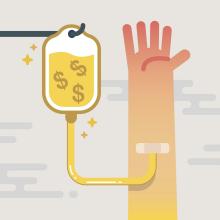A new study has found that although dose escalation is common in RA patients being treated with infliximab, the low price of infliximab biosimilars that are currently commercially available in the United States often outweighs switching to a similarly administered tumor necrosis factor inhibitor with no biosimilar, such as intravenous golimumab (Simponi).
“Given the 21% lower average sales price [ASP] of biosimilar infliximab-dyyb [Inflectra], as compared to the ASP of bio-originator infliximab, in Q3 2019, even infliximab dose[d] at 8 mg/kg [every] 6 weeks should be approximately neutral or cost saving, compared to golimumab IV,” wrote Jeffrey R. Curtis, MD, of the University of Alabama at Birmingham, and coauthors. The study was published in Arthritis Research & Therapy.
To determine if and when dose escalation of an infliximab biosimilar might offset the cost savings of its use, the researchers launched a cohort study of Medicare enrollees with RA who began treatment in 2013 (when intravenous golimumab first went on the market) through the end of 2016 (biosimilar infliximab-dyyb was first marketed in the United States in November 2016). They analyzed dose escalations and reimbursement amounts through 78 weeks for 5,174 patients who started infliximab and 2,843 patients who started golimumab. The golimumab patients were slightly older (70 years vs. 68.6 years) and more likely to receive monotherapy.
After 18 months, 5% of golimumab patients increased their dose, compared with 49% of infliximab patients (P less than .0001). Of patients who had no gap in infliximab treatment for greater than 10 weeks (n = 1,380), 72% had their dose escalated. Characteristics associated with dose escalation included being younger, being male, and not having chronic pulmonary disease. Physicians who owned their own infusion centers were 25% more likely to escalate doses of infliximab (adjusted odds ratio, 1.25; 95% confidence interval, 1.09-1.44).
Mean costs paid by Medicare for the first 18 months of treatment were significantly higher for golimumab ($28,146; 95% CI, $27,497-$28,810), compared with infliximab ($21,216; 95% CI, $20,737-$21,706). An analysis of patients who persisted on therapy for all 18 months with no treatment gap greater than 10 weeks revealed an even greater disparity in cost: $43,940 for golimumab (95% CI, $42,849-$45,058) versus $34,671 for infliximab (95% CI, $33,891-$35,470).
According to a sensitivity analysis, 34% of infliximab-treated patients increased their dose to 5 mg/kg, 5% increased their dose to 8 mg/kg, and 4% increased their dose to 10 mg/kg. In a modeling scenario that considered cost, dose, and frequency, infliximab at 8 mg/kg dosed every 6 weeks was cheaper than golimumab with a biosimilar discount of greater than 25%. At 10 mg/kg dosed every 6 weeks, infliximab was cheaper than golimumab with a biosimilar discount of 30% or more.
That said, given comparable clinical outcomes with other RA biologics plus the increased indirect costs and greater risk of serious infections associated with infliximab dose escalation, the researchers noted that “escalation beyond 5 mg/kg is probably not a prudent course of treatment for most RA patients, compared to switching to alternative treatment options.”
Though they emphasized their study’s strengths – including the impressive sample size of older Medicare patients – the authors also acknowledged its limitations, such as a lack of information on the clinical reasons for treatment discontinuation and dose escalation. They also were not able to examine whether safety or tolerability played a role in patients’ treatment decisions.
Two of the four authors reported receiving research grants and consulting fees from various medical and pharmaceutical companies, and one other author reported owning stock in Amgen.
SOURCE: Curtis JR et al. Arthritis Res Ther. 2019 Dec 12. doi: 10.1186/s13075-019-2022-8.


